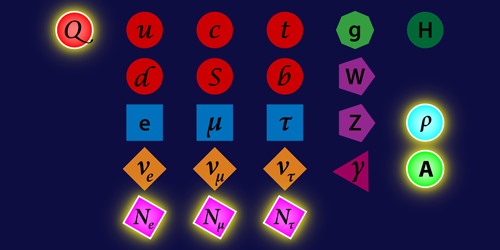February 20, 2017 report
Group introduces six new particles to standard model to solve five enduring problems

(Phys.org)—A quartet of researchers has boldly proposed the addition of six new particles to the standard model to explain five enduring problems. In their paper published in the journal Physical Review Letters, Guillermo Ballesteros with Université Paris Saclay, Javier Redondo with Universidad de Zaragoza, Andreas Ringwald with Max-Planck-Institut für Physik and Carlos Tamarit with Durham University describe the six particles they would like to add and why.
The standard theory is, of course, a model that has been developed over the past half-century by physicists to describe how the universe works, and includes such things as the electromagnetic, strong and weak interactions, and also describes what are believed to be the particles that play a role in it all. To date, the theory lists 17 fundamental particles and has stood up against rigorous testing, but it still does not include explanations for what are considered to be some fundamental things.
The researchers are quick to point out that they are not proposing any new physics. Instead, they have assembled what they believe are the most promising theories regarding several problems with the standard model and their possible solutions, and have put them together as an outline of sorts for research moving forward.
The five theories targeted by the research team seek to answer four major questions and to correct a problem with another: What exactly is dark matter, what caused inflation to come about, why is a neutrino so light, and why is there more matter than antimatter? The new model also seeks to correct a theoretical problem regarding asymmetry in the strong force.
The team has named their new model SMASH for "Standard Model Axion See-saw Higgs portal inflation." The proposed particles are rho (to help explain inflation), the axion (to help explain dark matter) a color triplet fermion and three heavy right-handed neutrinos.
It is still far too early to predict whether the model will be accepted by the physics community, but one thing it has in its favor is that the predictions it makes are clear, which means they can be tested and either proved or disproved. It should be noted that the theory does not include such things as the hierarchy problem or deal with the cosmological constant.
More information: Guillermo Ballesteros et al. Unifying Inflation with the Axion, Dark Matter, Baryogenesis, and the Seesaw Mechanism, Physical Review Letters (2017). DOI: 10.1103/PhysRevLett.118.071802
ABSTRACT
A minimal extension of the Standard Model (SM) providing a complete and consistent picture of particle physics and cosmology up to the Planck scale is presented. We add to the SM three right-handed SM-singlet neutrinos, a new vector-like color triplet fermion and a complex SM singlet scalar σ whose vacuum expectation value at ∼1011 GeV breaks lepton number and a Peccei-Quinn symmetry simultaneously. Primordial inflaton is produced by a combination of σ and the SM Higgs. Baryogenesis proceeds via thermal leptogenesis. At low energies, the model reduces to the SM, augmented by seesaw-generated neutrino masses, plus the axion, which solves the strong CP problem and accounts for the dark matter in the Universe. The model can be probed decisively by the next generation of cosmic microwave background and axion dark matter experiments.
Journal information: Physical Review Letters
© 2017 Phys.org





















